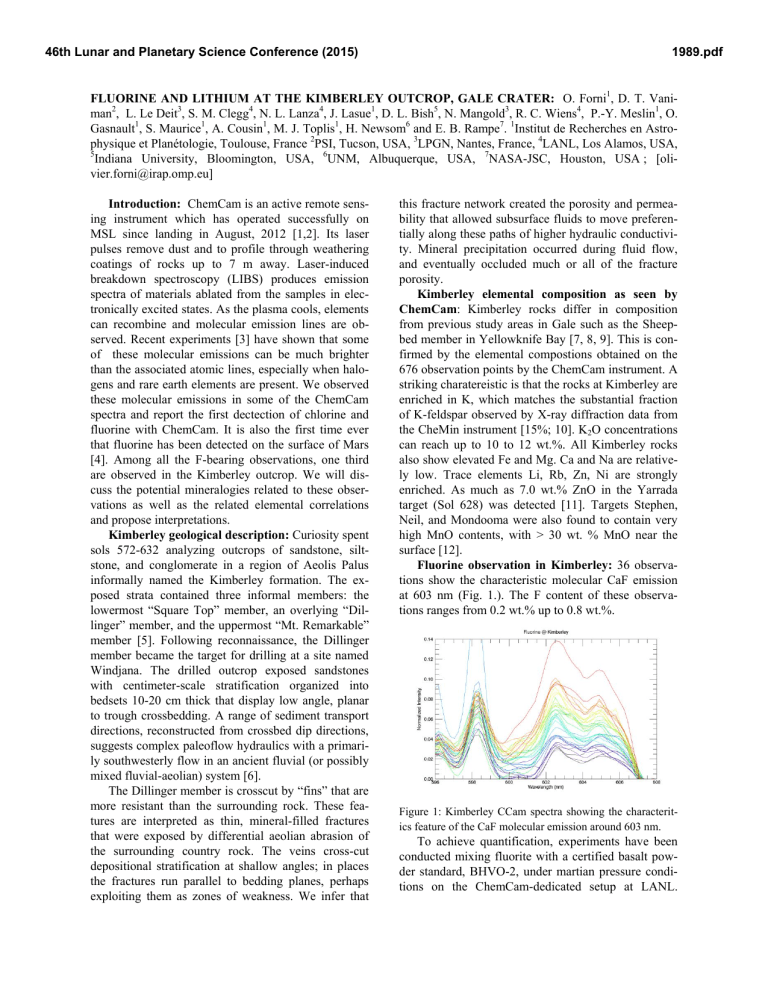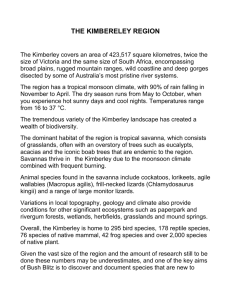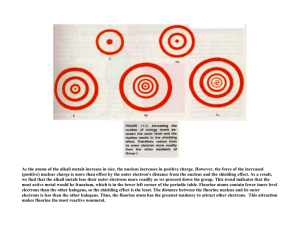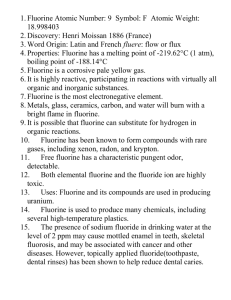Fluorine and Lithium at the Kimberley Outcrop - USRA

46th Lunar and Planetary Science Conference (2015) 1989.pdf
FLUORINE AND LITHIUM AT THE KIMBERLEY OUTCROP, GALE CRATER: O. Forni
1
, D. T. Vaniman
2
, L. Le Deit
3
, S. M. Clegg
4
, N. L. Lanza
4
, J. Lasue
1
, D. L. Bish
5
, N. Mangold
3
, R. C. Wiens
4
, P.-Y. Meslin
1
, O.
Gasnault
1
, S. Maurice
1
, A. Cousin
1
, M. J. Toplis
1
, H. Newsom
6
and E. B. Rampe
7
.
1
Institut de Recherches en Astrophysique et Planétologie, Toulouse, France
2
PSI, Tucson, USA,
5
Indiana University, Bloomington, USA,
3
LPGN, Nantes, France,
6
UNM, Albuquerque, USA,
7
4
LANL, Los Alamos, USA,
NASA-JSC, Houston, USA ; [olivier.forni@irap.omp.eu]
Introduction: ChemCam is an active remote sensing instrument which has operated successfully on
MSL since landing in August, 2012 [1,2]. Its laser pulses remove dust and to profile through weathering this fracture network created the porosity and permeability that allowed subsurface fluids to move preferentially along these paths of higher hydraulic conductivity. Mineral precipitation occurred during fluid flow, and eventually occluded much or all of the fracture porosity. coatings of rocks up to 7 m away. Laser-induced breakdown spectroscopy (LIBS) produces emission spectra of materials ablated from the samples in electronically excited states. As the plasma cools, elements can recombine and molecular emission lines are observed. Recent experiments [3] have shown that some of these molecular emissions can be much brighter than the associated atomic lines, especially when halogens and rare earth elements are present. We observed these molecular emissions in some of the ChemCam spectra and report the first dectection of chlorine and fluorine with ChemCam. It is also the first time ever that fluorine has been detected on the surface of Mars
[4]. Among all the F-bearing observations, one third are observed in the Kimberley outcrop. We will discuss the potential mineralogies related to these observations as well as the related elemental correlations and propose interpretations.
Kimberley geological description: Curiosity spent sols 572-632 analyzing outcrops of sandstone, siltstone, and conglomerate in a region of Aeolis Palus informally named the Kimberley formation. The exposed strata contained three informal members: the lowermost “Square Top” member, an overlying “Dillinger” member, and the uppermost “Mt. Remarkable”
Kimberley elemental composition as seen by
ChemCam : Kimberley rocks differ in composition from previous study areas in Gale such as the Sheepbed member in Yellowknife Bay [7, 8, 9]. This is confirmed by the elemental compostions obtained on the
676 observation points by the ChemCam instrument. A striking charatereistic is that the rocks at Kimberley are enriched in K, which matches the substantial fraction of K-feldspar observed by X-ray diffraction data from the CheMin instrument [15%; 10]. K
2
O concentrations can reach up to 10 to 12 wt.%. All Kimberley rocks also show elevated Fe and Mg. Ca and Na are relatively low. Trace elements Li, Rb, Zn, Ni are strongly enriched. As much as 7.0 wt.% ZnO in the Yarrada target (Sol 628) was detected [11]. Targets Stephen,
Neil, and Mondooma were also found to contain very high MnO contents, with > 30 wt. % MnO near the surface [12].
Fluorine observation in Kimberley: 36 observations show the characteristic molecular CaF emission at 603 nm (Fig. 1.). The F content of these observations ranges from 0.2 wt.% up to 0.8 wt.%. member [5]. Following reconnaissance, the Dillinger member became the target for drilling at a site named
Windjana. The drilled outcrop exposed sandstones with centimeter-scale stratification organized into bedsets 10-20 cm thick that display low angle, planar to trough crossbedding. A range of sediment transport directions, reconstructed from crossbed dip directions, suggests complex paleoflow hydraulics with a primarily southwesterly flow in an ancient fluvial (or possibly mixed fluvial-aeolian) system [6].
The Dillinger member is crosscut by “fins” that are more resistant than the surrounding rock. These features are interpreted as thin, mineral-filled fractures that were exposed by differential aeolian abrasion of the surrounding country rock. The veins cross-cut depositional stratification at shallow angles; in places the fractures run parallel to bedding planes, perhaps exploiting them as zones of weakness. We infer that
Figure 1: Kimberley CCam spectra showing the characteritics feature of the CaF molecular emission around 603 nm.
To achieve quantification, experiments have been conducted mixing fluorite with a certified basalt powder standard, BHVO-2, under martian pressure conditions on the ChemCam-dedicated setup at LANL.
46th Lunar and Planetary Science Conference (2015) 1989.pdf
Twelve mixing ratios ranging from 0.07 wt.% to 50 wt.% CaF
2
were analyzed and for each mixture five observation points were acquired. The 30 spectra at each observation point were averaged together. After careful processing of the data [13] it is possible to draw a relationship between the area of the CaF emission band centered at 603 nm and the amount of fluorine present in the sample. With these new calibration experiments, a detection limit of about 0.2 wt.% fluorine is reached [4].
It is notable that these CaF observations are spread throughout all units of the Kimberley outcrop. Interestingly, all 9 points of the Dillinger target (Sol 628) contain fluorine at a level of about 0.5 wt.%, indicating that fluorine is present in one of the major phases and not as accessory phases..
Correlation with major elements: Among the Kimberley observations, fluorine is generally correlated with K, Al, Si and Mg in that decreasing order. These correlations suggest that the F-bearing phase may be compatible with a silicate phase. Of the phases determined by CheMin in the Windjana drill sample the likeliest hosts are clay minerals or the amorphous component. Several ChemCam points having around
0.6 wt.% F and 5 wt.% Ca display a positive Ca-F correlation, making fluorite [CaF
2
] a plausible phase.
Fluorite was not detected by CheMin but may be present below XRD detection limits.
Figure 2: Plot of the Li content vs. the MgO content for targets having more tha 0.2 wt.% F.
Correlation with minor and trace elements : In
Kimberley, fluorine is mainly correlated with lithium.
The average lithium content in these high fluorine targets is of the order of 50 ppm with a maximum of about 140 ppm in the point Frome_Rock-5. The value of 50 ppm is comparable to what is observed at Bathurst_Inlet [14]
Lithium observation in Kimberley: The average lithium content is of the order of 25 ppm for the 676 observations on the Kimberley outcrop. This value is much larger than the average Li content of 5 to 10 ppm observed so far with ChemCam [14] and in the SNC meteorites [15]. For those targets that contain fluorine, lithium exhibits a very strong correlation with magnesium (Fig. 2).
Interpretation : On Earth, fluorine and lithium are widespread in micas [16]. This is of great importance in the study of clay minerals because of the degradation of the micas, by weathering, through illite to mixed-layer clays and then to smectites which are observed in the CheMin data [10]. The lithium is generally not retained by clay minerals at the site of this transformation; because it is highly mobile, it is soon weathered out of the mica and either carried away in solution or incorporated into the structure of newly formed clay minerals. Although undetected by Che-
Min, micas may occur in sediment source regions and they should be considered as possible lithium sources .
A relation may exist between the content of lithium and the content of fluorine in smectites. In samples of smectite containing less than 1 wt.% fluorine, the lithium content increases with the fluorine content [17] .
High temperature hydrothermal processes in granodioritic settings are often invoked to explain these mineralogical associations, with formation of clays from chloritization of micas These alteration processes are accompanied by feldspathization at temperatures above 300°C. However, illite/micas and Mg-smectites may provide from distinct alteration type, the latter suggesting more low-T alteration, so that the observed minerals may not form in a single process. Alteration of source rocks at high-T occurring first and then alteration of transported sediments by fluids during diagenesis occurring next. Finally, when the temperature decreases to ~100°C, fluorite can precipitate in place simultaneously with the zinc and manganese oxides.
References: [1] Maurice S. et al. (2012) SSR, 170,95-
166 [2] Wiens R.C. et al. (2012) SSR, 170, 167-227 [3] Gaft
M. et al. (2014) SCAB, 98, 39-47 [4] Forni et al., GRL (accepted) [5] Gupta, S. et al. (2014) AGU Fall meeting [6]
Grotzinger J. et al. (2014) AGU Fall meeting [7] McLennan
S. M. et al. (2014) Science, 343, doi: 10.1126/science.
1244734 [8] Mangold N. (2014) AGU Fall meeting [9] Le
Deit L. et al. (2015) this meeting [10] Rampe et al. (2014)
AGU Fall meeting [11] Lasue J. et al. (2015) this meeting
[12] Lanza N. L. et al. (2015) Nature geosciences (submitted)
[13] Wiens R.C et al. (2013) SCAB, 82, 1-27 [14] Olllila et al. (2014), 119, 1-31 [15] Filiberto J. E. et al. (2012) MAPS,
47, 1256–1273. [16] Tischendorf G., Föster H. and
Gottesmann B. (1999) Min. Mag., 63(1), 57–74 [17] Starkey
H. C. (1982) Geol. Surv. Bull. 1278-F.







